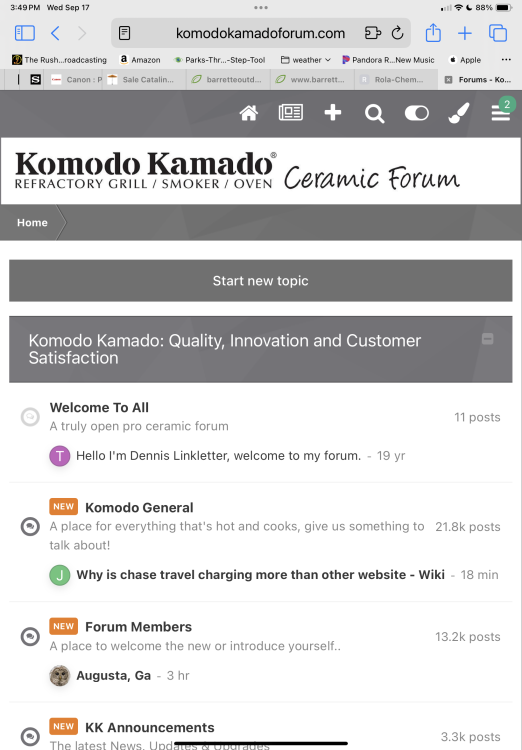-
Posts
2,178 -
Joined
-
Last visited
-
Days Won
20
Content Type
Profiles
Forums
Events
Everything posted by mguerra
-
Keep in touch with the customer. See if after a while he or she says they got tired of using the blower and just went to vents. I HAD to have a Stoker and a BBQ Guru, early on. Never use them anymore. Now I just start the CORRECT amount of charcoal, set the vents by eye, and read the smoke coming out the top. I like the Thermoworks Smoke thermometers because they have a dedicated radio receiver. I hate the app based ones that use your phone, most of those apps suck.
-

Goldens' Cast Iron Cooker
mguerra replied to David Chang's topic in The Ceramic World Online & Other Relevant Links
Any time I think about getting another cooker, it seems there’s nothing I could do on it I can’t do on my KK. I really want to get a Weber kettle, a WSM, a PK, some other Kamado like the Blaze and so on. Just to have some more toys. But I never do get one. Don’t need to. -

Goldens' Cast Iron Cooker
mguerra replied to David Chang's topic in The Ceramic World Online & Other Relevant Links
Blaze has that aluminum one that looks pretty cool. -
I still have some coco char logs from 2009… I think I’ll break them in smaller pieces and repackage them for ready use.
-
I’m not a fan of normally grilled meat, seared outside and pink inside. We use the KK for its sous vide like capabilities. For a steak, I’ll cook it indirect high up in the dome, above a typical hot grilling fire. It takes a little longer than straight grilling, gets a lot more smoke, and comes out pretty evenly cooked from surface to center. Once it hits finish temp or just under you could sear it but I don’t. We cook big beef tenderloins this way on Christmas Eve, and it gets rave reviews! Also standing rib roasts. If you like a charred outside and rare inside this isn’t for you. Of course for burgers, sausages and dogs we just grill them on the open fire, albeit I do it on the top grate. Takes just a bit longer and gets some more smoke.
-
Yeah that’s him. As far as Pepperidge Farm, that blew right over my head.
-
There was a dude who was/ is a butcher in Chicago who used to post here a lot. Anybody remember that guy? Is he still on the board?
-
Well it’s five years later and Dennis solved another problem for me, gratis. Top notch CS.
-
OK works fine on desktop computer, thanks!
-
Does anyone actually use the Polder branded products? I wonder how many people on The Forum know why that thermometer cable port is called Polder in the first place. What is the maximum number of thermometer probes anybody has managed to get through that port? I have used a number of different brands of thermometers over the years, but have since firmly landed in the Thermoworks camp.
-
This is on an iPad by the way
-
-
-
Yeah I’m missing something here. When I click on the little magnifying glass search button at the top of a page there is no “member search” tab. Eh, it’s not that important I guess. But thanks.
-
Actually, I wasn’t successful pulling up a member list in the search bar. I typed in “member list” and “members” and got nothing. Your link worked but I couldn’t see what your link said.
-
Ok thanks.
-
Also, I thought we had an alphabetical list of forum members and maybe a link to their profile. Can’t find that.
-
Years ago each post was numbered so you could easily reference one. That seems to be gone. Also, whenever anyone posted there was a running count of how many posts they had made. Don’t see that anymore. And what’s that little rocket next to my icon?
-
There are a number of YouTube videos showing how to do a low and slow tri-tip so I tried it. It was my first tri-tip. I’ve never tried the Santa Maria method. I removed all of the fat and put it in an aluminum pan and put that on the fire to make smoked tallow. The rub was Jane’s crazy mixed up salt and fresh cracked pepper. I never use pre-cracked pepper from the store because it loses all of its volatile organics. The fire ran at 225°F and it was a mixture of Royal Oak lump and Hickory and coffee wood chunks, I used that giant baking stone as my heat deflector and roasted the tri-tip on the top rack. When it hit an internal temp of 165 I pulled it off the fire along with the rendered smoky tallow and poured tallow all over the meat and wrapped it in foil. It went back on the fire, and I started probing for tenderness when it hit an internal temp of 190. Once it was butter tender, I pulled it off the fire and let it rest on the countertop covered in towels for several hours. I sliced it and served it with a little drizzle of the smoky tallow on each slice. It was just as fabulous as any other thing you might make on your KK. It was so good, I replicated the exact cook again two weeks later! By sheer coincidence when I did the first one, my across the street neighbor also did a tri-tip Santa Maria style. He sent me a text and said hey man have you ever done a tri-tip before? He did his Santa Maria style and didn’t like it. He thought it was too tough and not very juicy. I said that’s hilarious that you asked me. I just did one today for the first time ever. So I told him to wrap his in foil and put it in his oven at 200° and probe it until it was butter tender, which he did. He called me back later that evening and said it was fabulous that way. So I gave him the lowdown on how to do it low and slow from start to finish on his BGE. I will absolutely be doing this again. I will post a little abbreviated video of it on YouTube maybe I can figure out how to come back here and put a link. Anyway, my YouTube channel is mguerramd. OK, it’s been so long since I posted the form I can’t remember how to embed a YouTube video in a post so here’s a link: Oh well, I guess that’s how you embed it!
- 1 reply
-
- 3
-

-

-
That deflector was originally designed to protect the wood knob on the bottom vent. They were getting scorched, cracked and breaking off. Dennis is always updating and improving things, so I don't know what the current vents use for knob material, but if it is still wood, probably best to leave that deflector in place.
-
Anytime you can reasonably and safely do so, decompress any seals and gaskets you have. For the KK, when the fire is out, move the lid latch to position one and pop the top vent loose. Gaskets last longer if you can decompress them. Washing machine door, dryer door, dishwasher door, scuba regulator, fishing reel drag, needle valves, anything with a gasket or o-ring that you don’t have to tighten down on all the time, don’t. When reasonable, I leave the KK lid fully open. Look around at all your stuff and you’ll find applications for this concept. For example, I keep a spare Polaris backup valve for the pool. There’s an o-ring in the case halves and in the outlet for the reverse jet. I keep it disassembled with a coating of waterproof grease on these o-rings. I only reassemble it and compress the o-rings when I put it in service. When you take your garden hoses out of service for the season, release them from the spigots to decompress the o-rings and if you have any quick connects with o-rings, release them. Pelican or Seahorse cases, plastic ammo boxes, the list is endless. Look around and you’ll find lots of seals and o-rings you can extend the life on.
-
I'm trying to agitate...
-
Get a shop vac. Everyone needs at least one. Not just for your KK.




